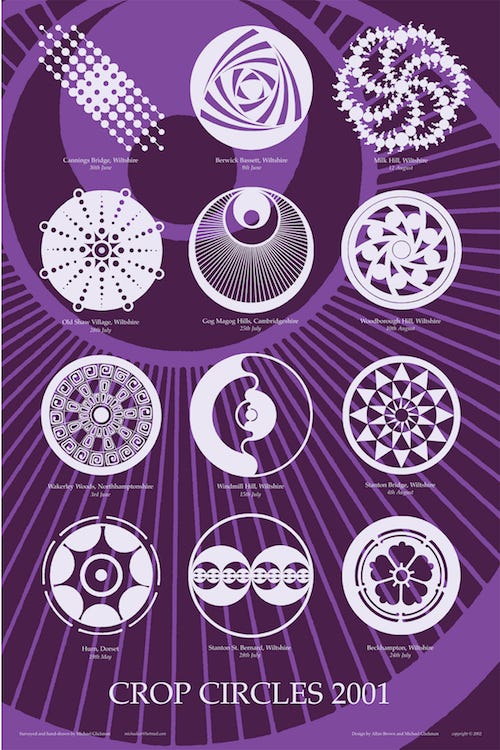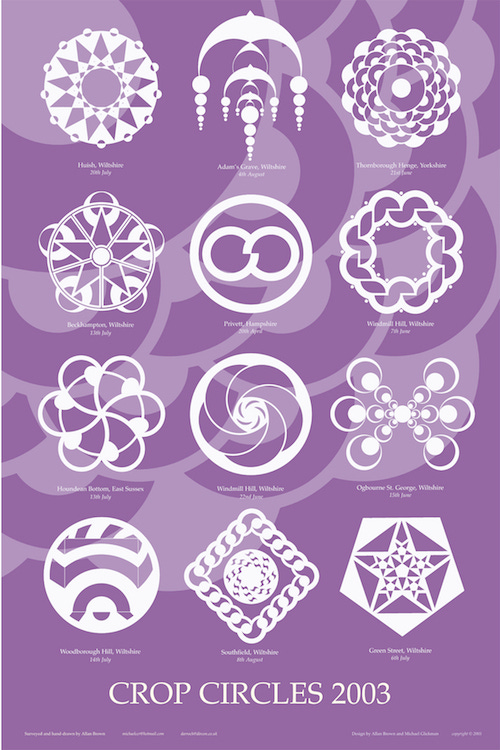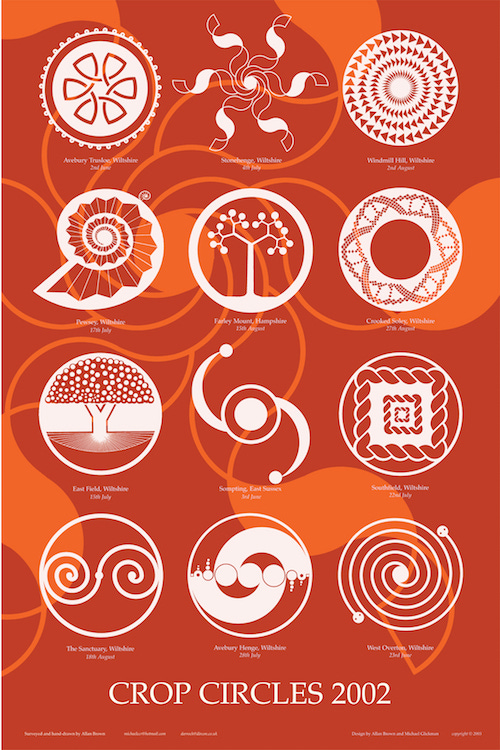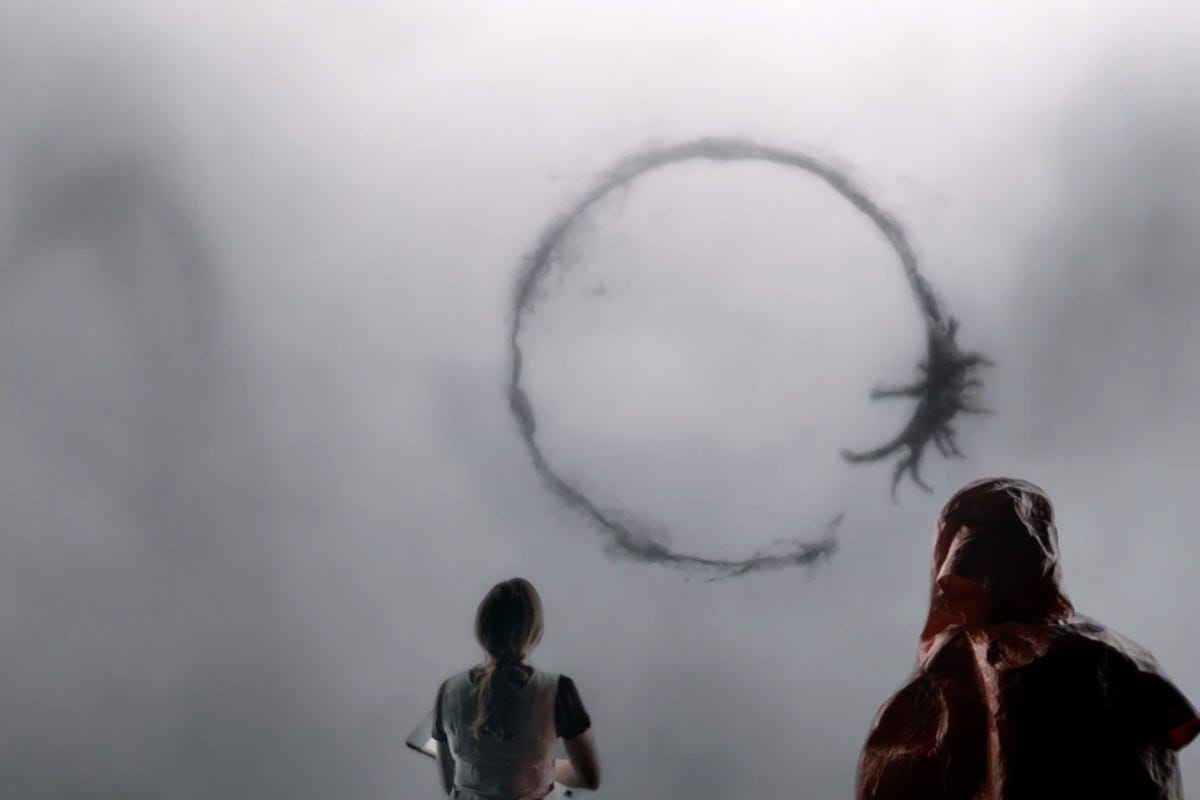Happy New Year! Now what about the aliens?
My fascination with the subject of ETs, UFOs, crop circles, and alien encounters has been rekindled. Excited to share ideas with you on Sunday.
Crop Circle, Milk Hill, 2001
As we close the door on the bizarre travail that was 2020 and enter the still unknown portal of 2021, I find myself thinking, incessantly, yet again, about extraterrestrials.
The new film Phenomenon, the Bob Lazar documentary on Netflix, and the interview with the former head of Israel’s Space Defense agency, where he states that the US and Israeli governments have been in direct contact with a “galactic federation” of ETs for decades, all rekindled my interest. Now we are told that the US Military must issue an official report on UFOs within the next six months. Things are heating up!
Next Sunday, I am offering an online lecture / workshop: ETs, UFOs, Psychedelic Encounters, and the Collective Unconscious (register here). I first wrote about ETs, UFOs, crop circles, and alien abductions in my book 2012: The Return of Quetzalcoatl (2006). I revisited the subject in a recent short book, The Occult Control System. The whole area falls into the category of what Terence McKenna called “thrown-away knowledge,” outside of our ordinary categories and beliefs. I find the subject of ETs and UFOs to be analogous, in some ways, to the area of psychedelics when I started to investigate them in the late-1990s. At that point, in New York anyway, you would be mocked and ridiculed if you professed an interest in psychedelics and altered states of consciousness. Ridicule and mockery serve a protective function for the status quo. It is the way we keep threatening ideas and possibilities outside of the realm of acceptable discourse.
It is difficult for most people to explore or seriously consider any subject until there is a stable field of coherence — a collective agreement — about what it means. I optimistically thought that the research I presented on the crop circles in my 2012 book would help to inspire a massive investigation of the subject. Instead, it seems like interest in this area has diminished over time, even though extraordinary patterns continue to appear every summer.
A few researchers (including the late Michael Glickman, who created the lovely crop circle art I have included in this newsletter) told me that the crop circles seemed almost like a computer program. The program was designed to run for a certain length of time and probably designed to accomplish a particular goal. The makers of the patterns seem to be encoding a knowledge system into these formations. They left them for humanity to explore on our own terms — or not, as we choose.
I interviewed the Chief Astronomer for SETI, Seth Shostak. He scoffed at the idea that these formations could be an authentic communication from non-human entities. He said that if aliens wanted to communicate with us, they would probably just leave an “Encyclopedia Galactica” on our doorstep. I found this to be a very strange response.
Why would Shostak, or anyone, know how a more evolved form of consciousness and intelligence might choose to interact with us? In fact, I see many good reasons to consider the crop circles a perfect vehicle for “higher intelligences” to introduce themselves to modern humanity. The formations are a form of public address that cannot be controlled by governments or military. The images seem deliberately “open-source,” available to anyone who wants to research them. Instead of shocking us with a sudden apparition, these patterns diffuse slowly through the collective consciousness.
In the summers of 2001 and 2002, I lived in Glastonbury, England, using it as a base for investigating the crop circles that appeared in the region — often near Neolithic stone circles and mounds like Avebury, Stonehenge, and Silbury Hill. I would drive to new ones as soon as they appeared, where you could often feel a palpable energy shift. I interviewed everyone I could who was connected to the crop circles. This included physicists who published peer-reviewed papers on anomalies within the patterns, geometers who studied the mathematical structure of the patterns, mystics, and the artists who claimed to make some of them and were cynically confident they were all human-made.
The artists, calling themselves the “circlemakers,”developed a cottage industry: Producing crop circles for corporations, as well as insinuating they were responsible for the most amazing ones — such as the vast, flawlessly executed spiraling fractal pattern that appeared on Milk Hill in 2001. Glickman did not believe this one was human made. He thought it was like “an emphatic fist banging on table,” trying to get the world’s attention. One fascinating aspect of the crop circles was that it was extremely difficult to prove, with certainty, that any one of them was not made by people.
After months of research and many sleepless nights, I felt I understood something: A crucial part of the message of the crop formations was this phenomenological uncertainty. We can only have revealed to us what we are ready to receive. For instance, those who came to the crop circles convinced that all of the patterns were made by human artists tended to only discover evidence supporting their bias. Those who believed they were made by other beings would encounter “balls of light” in the fields. Those who thought it was a military plot would encounter black helicopters over the fields. And so on.
The patterns seemed to teach me that the nature of reality is, on a very deep level, subjective (or, perhaps, intersubjective is more accurate). I quoted Nietzsche in my 2012 book: “Indeed, what forces us at all to suppose that there is an essential opposition of ‘true’ and ‘false’? Is it not sufficient to assume degrees of apparentness and, as it were, lighter and darker shadows and shades of appearance—different ‘values,’ to use the language of painters?”
Such an idea is very difficult for contemporary people who have grown up in a scientific, materialist culture to comprehend or integrate. We believe in hard-and-fast distinctions between “true” and “false,” “real” and “unreal.” Not just the crop circle phenomenon, but the UFO, flying saucer, alien visitation and alien abduction phenomenon as a whole seems almost intentionally designed to break down these distinctions.
About the mass flying saucer sightings in the late-1940s, Carl Jung wrote: “It is difficult, if not impossible, to form any correct idea of these objects, because they behave not like bodies but like weightless thoughts.” Jung saw it as “a phenomena connected with archetypal psychic processes” — in particular, the archetypes of the Apocalypse, as the “coming of the Self” into conscious realization, and the archetype of psychic wholeness, expressed by the round shape of the saucers.
Not only do the crop formations seem particularly linked to the Western esoteric tradition, they also constitute a kind of Post Modern Mystery School — an invitation from the Cosmos to engage with ancient knowledge that can now be integrated and synthesized with the scientific understanding of reality.
In the science fiction film Arrival, humanity learns to communicate with benevolent octopus-like ETs who speak by tracing intricate circular patterns out of ink. Once understood, these signs change humanity’s consciousness of temporality, from a limited linear construct to time as a weaving of synchronicity. I believe the crop formations accomplish the same objective, if we pay close attention.
Paid subscribers to my newsletter get free tickets to this and subsequent talks. Please subscribe here:
If you enjoy what you read here, why don’t you share the newsletter with your friends and community? After all, it is free to follow.










